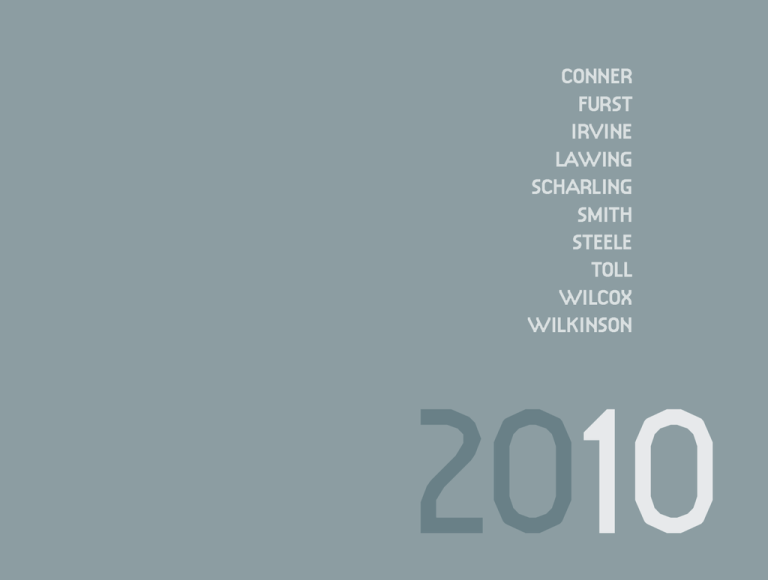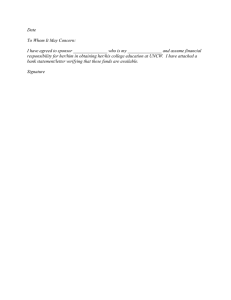31 21 DPOOFS GVSTU
advertisement

DPOOFS GVSTU JSWJOF MBXJOH! TDIBSMJOH TNJUI TUFFMF UPMM XJMDPY XJMLJOTPO 3121 DPOOFS GVSTU JSWJOF MBXJOH! TDIBSMJOH TNJUI TUFFMF UPMM XJMDPY XJMLJOTPO VOJWFSTJUZ PG OPSUI DBSPMJOB XJMNJOHUPO TUVEJP BSU GBDVMUZ FYIJCJUJPO ! 3121 VOD!XJMNJOHUPO!DBNQVT DVMUVSBM!BSUT!CVJMEJOH!BSU!HBMMFSZ KBOVBSZ!25!Ñ!GFCSVBSZ!2: DPOOFS GVSTU JSWJOF MBXJOH! TDIBSMJOH TNJUI TUFFMF UPMM XJMDPY XJMLJOTPO 6 8 : 22 24 26 28 2: 32 34 ! ANN CONNER Working in woodcut is always a challenge as the grain of the wood is so captivating. My woodcuts are, in many ways, a response to this. I like carving into the natural flat wood, or mechanically clean surface of linoleum, however using high-tech power carver, or laser engraving blocks. Relief is the oldest form of printmaking, and it continues to have relevance for me. “WestPark” is a ubiquitous title referencing parks and wooded locals. The significance is universal. WestPark 1 and WestPark 2 are from a suite of four woodcuts. I carved oak woodblocks with an Automach power chisel and printed the blocks onto handmade Thai Unryu papers at Flatbed Press, Austin, Texas. Spirograph and compass-drawn images float on neutral grounds. Colors are earthy and dense. WestPark 3 Framed Woodcut 51" x 39" DONALD FURST I am interested in spatially ambiguous architectural settings that imply choice and risk. I take pleasure in using mezzotint and stone lithography, classic printmaking processes considered commercially obsolete in our digital age. Conundrum Copper plate mezzotint 7" x 5" 11 EDWARD IRVINE My graphic design practice is in service to cultural institutions, artists and authors working in both print and digital media. By Stephen Adly Guirgis Directed by Renée Vincent Co-sponsored by the Upperman Center FEBRUARY 25, 26, & 27, 2010 @ 8pm FEBRUARY 28 @ 2 pm UNCW’s Main Stage Theatre The Cultural Arts Building Box Office opens one hour prior to performances for ticket sales and retrieval of will-call tickets. General seating. An EEO/AA Institution TICKET INFORMATION (910.962.2793) General Public $12 UNCW Employees/Alumni $10 UNCW Students $ 5 Season Punch Card Kenan Auditorium Box Office 910.962.3500 www.uncw.edu/thr UNCW Department of Theatre Our Lady of 121st Street Digital print 22" x 34" 13 ERIC LAWING The universal is of the dust in our shoes. Beauty surrounds us. I try to realize the complexity of the moment, the beauty and tragedy, the gaining and losing of an ancient connection between imaginations, the world outside, and the drawing. In the woods there is a constant, simultaneous growth and deterioration. My drawing processes have become primarily about formation and destruction, defining and redefining, one form giving away to another. This is especially true of my tree drawings. Tree, #12 Pencil, charcoal & lacquer on paper 42" x 26" 15 CASEY SCHARLING Painting allows me to replay a moment in time and examine the circumstances of the solitary figure and the interaction of individuals, particularly mothers and children. Initial layering with loose washes of color ensures that each piece materializes with ease and speed. The image then takes shape around the preliminary abstracted arrangements, and I respond simultaneously to the images referenced and the surface of the canvas. Strokes of thick paint applied in the final layers weave together shapes of color and patterns of light to create the figures. Baptism (detail, lower left) Acrylic and Oil on canvas 46" x 60" 17 VICKY SMITH Clay is the primary material in all of my art. The process of making the wall pieces begins with the clay; I gather the clay from my property in Greene County. By gathering the clay I am able to see the clay in its most natural state, in the ground. The clay on this site is formed in layers of color red, orange, yellow, gray and green. My goal is to preserve colors of the clay without adding colorants or oxides; this is accomplished by adding non-toxic white glue to the clay. The natural colors and textures of the clay is preserved and permanently fixed to the reclaimed wood. Terra 1 Clay & glue on reclaimed wood 9.25" x 24" x .5" 19 ANDI STEELE Twisted Triptych is part of a new series focused on framing space. By building a structure with an open linear construction, a place is created that is both enclosed and exposed. When entered, the viewer is separated from, but still visually connected to, the surrounding environment. What they see is obstructed, as are they, blurring the boundaries between interior and exterior. Twisted Triptych Conduit, fittings, wire 7' x 7' x 9' 21 PAM TOLL Early work was influenced by narrative and a family tradition of quilt making. Working with mixed media in a way parallel to my fragmented existence as mother, teacher, artist, I found a way to express what I was thinking. Collage allowed for a complex visual field which was not strictly abstract. It also fit family life as I could work an hour or two as time permitted. I still make collages and often use them as sketches for larger work. When painting, I am inclined towards narrative fed by real and imagined stories. Everything I know and am converges when I paint. I am driven by memory, intention, and intuition, and am thinking all over the place. Fragments swim in a kind of chaos and are plucked out and juxtaposed. Working in a circular way, I add and subtract characters, story lines, dreams, memories, symbols, and secret languages–walking a tightrope between manipulation and surrender. Primitive Poetry (detail, lower left) charcoal, pastels, a silk scarf, acrylic paint & oil paint on canvas 55" x 92" 23 AARON Paddled Jar Ceramic with glaze 6" x 7" x 7" WILCOX I am interested in potential. Potential energy; potential fit; potential function. The work that I do is set up to explore this potential and while I have guidelines, rules, and ideas, I do not have a specific outcome in mind. There is no degree of manufacture. This is the way of working that I am interested in. I am not interested in the happy accident or the fabrication of an idea. I am interested in the idea. The thought; the challenge. That is what makes art critical and works to formulate questions that have answers yet to be established. It is difficult to balance this way of working without it becoming relativistic. A context needs to be established to determine success. For my current work, that context continues to be the defining quality of ceramics—function. It is a re-working of the idea, one that moves afield of use or ergonomics and deals more with fit and work—what I believe to be function’s underlying questions. I want to get to this idea, remain bound in the tradition of clay with its history and malleability, and explore possibilities. 25 CARLTON WILKINSON During my visit to Colombia in 2008, I visited a small village called Palenque de San Basilio, which is approximately 60 miles southeast of Cartenga, Colombia. This and other African villages were born out of the struggle for freedom from Afro-Columbian slavery, which began in the 17th Century. In fact, the term Palenque means “Walled City.” Hauntingly, the village of approximately 3500 inhabitants resembles the rural villages that I visited in Nigeria and Ghana, West Africa in 2005. Upon my arrival there was little to distinguish the two, besides the various wall signage written in the Spanish/ Creole language called Palenquero and Spanish. Also, the people appear to reflect not only their African heritage but also the mixture of Native Indian and Spanish lineages. However, these Afro-Colombians have managed to maintain their distinct culture preserved from their origins of Angola and the Congo of Central Africa. These photographs are a glimpse into the traditions and lifestyles of the Palenque de San Basilio village. Couple on Porch Digital image 12" x 17" 27






